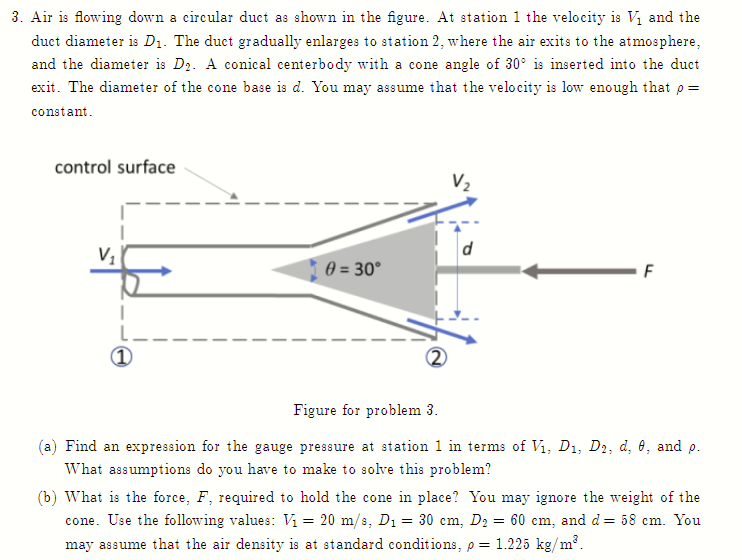Find an expression for the gauge pressure at station 1 in terms of V₁, D₁, D2, d, e, and p. What assumptions do you have to make to solve this problem? What is the force, F, required to hold the cone in place? You may ignore the weight of the cone. Use the following values: V₁ = 20 m/s, D₁ = 30 cm, D₂ = 60 cm, and d = 58 cm. You may assume that the air density is at standard conditions, p = 1.225 kg/m³.
Find an expression for the gauge pressure at station 1 in terms of V₁, D₁, D2, d, e, and p. What assumptions do you have to make to solve this problem? What is the force, F, required to hold the cone in place? You may ignore the weight of the cone. Use the following values: V₁ = 20 m/s, D₁ = 30 cm, D₂ = 60 cm, and d = 58 cm. You may assume that the air density is at standard conditions, p = 1.225 kg/m³.
Elements Of Electromagnetics
7th Edition
ISBN:9780190698614
Author:Sadiku, Matthew N. O.
Publisher:Sadiku, Matthew N. O.
ChapterMA: Math Assessment
Section: Chapter Questions
Problem 1.1MA
Related questions
Topic Video
Question

Transcribed Image Text:3. Air is flowing down a circular duct as shown in the figure. At station 1 the velocity is V₁ and the
duct diameter is D₁. The duct gradually enlarges to station 2, where the air exits to the atmosphere,
and the diameter is D₂. A conical centerbody with a cone angle of 30° is inserted into the duct
exit. The diameter of the cone base is d. You may assume that the velocity is low enough that p =
constant.
control surface
V₂
1
0 = 30°
V₂
F
Figure for problem 3.
(a) Find an expression for the gauge pressure at station 1 in terms of V₁, D₁, D₂, d, e, and p.
What assumptions do you have to make to solve this problem?
(b) What is the force, F, required to hold the cone in place? You may ignore the weight of the
cone. Use the following values: V₁ = 20 m/s, D₁ = 30 cm, D₂ = 60 cm, and d = 58 cm. You
may assume that the air density is at standard conditions, p = 1.225 kg/m².
Expert Solution
This question has been solved!
Explore an expertly crafted, step-by-step solution for a thorough understanding of key concepts.
This is a popular solution!
Trending now
This is a popular solution!
Step by step
Solved in 4 steps with 4 images

Knowledge Booster
Learn more about
Need a deep-dive on the concept behind this application? Look no further. Learn more about this topic, mechanical-engineering and related others by exploring similar questions and additional content below.Recommended textbooks for you

Elements Of Electromagnetics
Mechanical Engineering
ISBN:
9780190698614
Author:
Sadiku, Matthew N. O.
Publisher:
Oxford University Press

Mechanics of Materials (10th Edition)
Mechanical Engineering
ISBN:
9780134319650
Author:
Russell C. Hibbeler
Publisher:
PEARSON

Thermodynamics: An Engineering Approach
Mechanical Engineering
ISBN:
9781259822674
Author:
Yunus A. Cengel Dr., Michael A. Boles
Publisher:
McGraw-Hill Education

Elements Of Electromagnetics
Mechanical Engineering
ISBN:
9780190698614
Author:
Sadiku, Matthew N. O.
Publisher:
Oxford University Press

Mechanics of Materials (10th Edition)
Mechanical Engineering
ISBN:
9780134319650
Author:
Russell C. Hibbeler
Publisher:
PEARSON

Thermodynamics: An Engineering Approach
Mechanical Engineering
ISBN:
9781259822674
Author:
Yunus A. Cengel Dr., Michael A. Boles
Publisher:
McGraw-Hill Education

Control Systems Engineering
Mechanical Engineering
ISBN:
9781118170519
Author:
Norman S. Nise
Publisher:
WILEY

Mechanics of Materials (MindTap Course List)
Mechanical Engineering
ISBN:
9781337093347
Author:
Barry J. Goodno, James M. Gere
Publisher:
Cengage Learning

Engineering Mechanics: Statics
Mechanical Engineering
ISBN:
9781118807330
Author:
James L. Meriam, L. G. Kraige, J. N. Bolton
Publisher:
WILEY